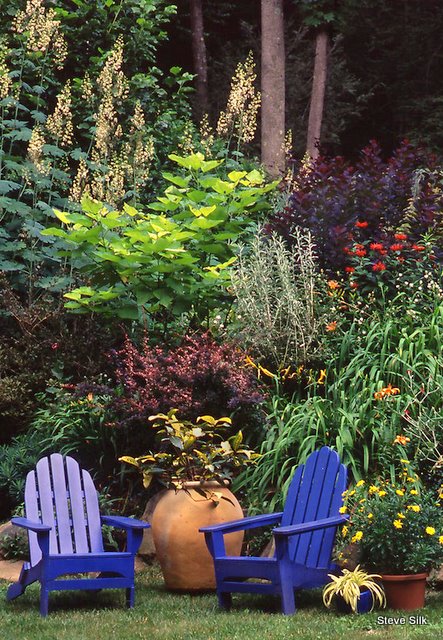
Surprise, surprise, surprise. That sort of sums up my response to the feedback on my January Plant Pick of the Month, plume poppy (Macleaya cordata). I fully expected my praise for the plumed wonder would generate at least a few screams of horror and shouts of alarm. While I can’t call it invasive, I feared others might. As it turned out, most of those who weighed in on the topic either already knew and loved this awesomely architectural but boistrous specimen or wanted to make its acquaintance.
Take my fellow GGW collaborator Adam Woodruff, who worried about plume poppy’s alleged aggression, but is now encouraged to give it a shot in some of his borders. Go for it Adam! It is going to fit right with the themes you’re already working. Lynn is planning a loose hedge of plume poppy to plant atop a small rise, the better to make a screen that should afford her a bit more privacy. Les has already overcome his initial trepidation, and popped a few plume poppys into his garden. Loves the blue foliage, which he captured neatly in this photo (top o’ the post).
At Sweet Home and Garden Chicago, Carolyn neatly summed up the issue of robustness by saying plume poppy is not invasive…but keep an eye on it. She also touts it as one of here favorite plants, but then she suffers from BBLS, Big Bold Leaf Syndrome. Is that contagious? I know I’ve got it bad too. So does Barbara, who’s owned Great Danes and St Bernhards and lusts after big showy plants (is there a trend here?) Helen thought the plume poppy gorgeous, as did Victoria-at least until she saw some pix of one of my Elephant ears (Colocasia spp.). Now she wants one of those. Clearly, she’s a fellow sufferer (or celebrant?) of BBLS.
Craig at Ellis Hollow says my post made him realize he took this Brobdingnagian plant’s charms for granted. He too values its vigor, and has found the plant’s not hard at all to control. He posted what he says is an “artsy-fartsy” photo showing a fine combo-lavender hued globes of allium riding the breeze against the blue-green cut leaf of the poppy to flesh out his post on the plumed one.
Ah, Jodi’s a kindred spirit! She writes: “I’m with you on plume poppy; I really love it especially on foggy summer days when the leaves and flowers are festooned with jewels of water. It’s in competition with some daylilies, Euphorbia ‘Fireglow’ and globe thistles (I love textured foliage), so they manage to sort it out amongst themselves, with a few rhizome removals in the spring by me.” Sounds like a free-for-all straight from the World Wrestling Federation. Bowled-over viewers will be down for the count. Cowabunga!
Nicole is ready to see if plume poppy grows in the tropics. She’s a fearless gardener who doesn’t shy away from spreading plants-and if there’s any place plants can really let their hair down and spread like there’s no tomorrow, well, it’s the tropics. Good thing Nicole has lots of space at her island home in the Caribbean. Speaking of warmer climes, Becky says those big leaves remind her of being in the tropics. “I wish I were there now,” she wrote. Wish I was too. Now if there’s anyone who knows about gardening in the tropics it’s Christopher C, recently relocated from Maui to the Asheville, NC area. Whe he first saw the plumed one, “it was an immediate, I must have that. I have plenty of room for it and after twenty years gardening in Maui, a little spreading in a zone 5b/6a seems rather innocuous. Let’s get real. The stuff freezes to the ground on an annual basis.” Christopher, I like your style!
For Neil a glimpse of the plume poppy prompted a case of love at first sight. BBLS? He asks if they are invasive (no!) but is unafraid. He’s looking for seeds. Can’t say as I have ever had a plume poppy self sow in my Connecticut garden, but GinnyH says spread it does – and rapidly, both by seed and by rhizomes, in her central Illinois garden. (Uh, Neil-aren’t you in that part of the world?). Even so, she writes, “I agree with you on it’s beguiling nature. If someone has the space and the inclination to try it, they should.” Agreed.
Out in Colorado, Kitt loves the plant’s drama and wonders what conditions it wants, fearing it won’t cotton to dry and sunny Denver. Au contraire! I’ve seen it growing like gangbusters out there. Farther north, in Calgary, garden coach Janice is looking–perhaps even as you read this–for space to plant one.
Across the pond in England, Sylvia likes the leaves, but worries plume poppy might topple in her windy site. Could happen. They are a little brittle. You might help it by providing a little preemptive staking to prop the plant up in the event of a big blow. If it goes timber, it’s toast. You can cut it back but it won’t regrow the same season. It just sits there and sulks, looking as if it got a bad haircut.
Last, but certainly not least, I’m hoping Josh at In The Country Garden & Gifts is onto something. One patch of his plume poppy threw a variegated sport. Alas, it was short lived and didn’t return the next year. He immortalized it digitally in a photo. And he wrote about its ephemeral appearance here. Josh, keep your eyes peeled. Maybe another variegated sport will crop up out there. If it does, we’ll all have yet another reason to love plume poppy. And a new reason to celebrate BBLS.
